Reno’s Grand Central
January – February 2013
The Biggest Little City’s Amtrak station has sent passengers to and fro for nearly a century.
Story and Photos By Greg McFarlane
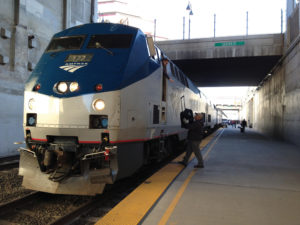
Train stations are buildings to revere and remark upon. An exceptional station reminds passengers that sometimes the destination can be as important as the journey. Unlike airports, the great railroad stations embody grandeur, not grandiosity. Their names alone can evoke memories—Grand Central, Waterloo, Gare du Nord. And in Nevada, Reno.
Reno’s Amtrak station fits so seamlessly in its downtown habitat, kitty-corner to Harrah’s at the intersection of Center Street and Commercial Row, that it’s easy to miss amid the towering hotel/casinos that surround it. Yet the current station (code name: RNO) has been a crucial part of The Biggest Little City’s history for 87 years.
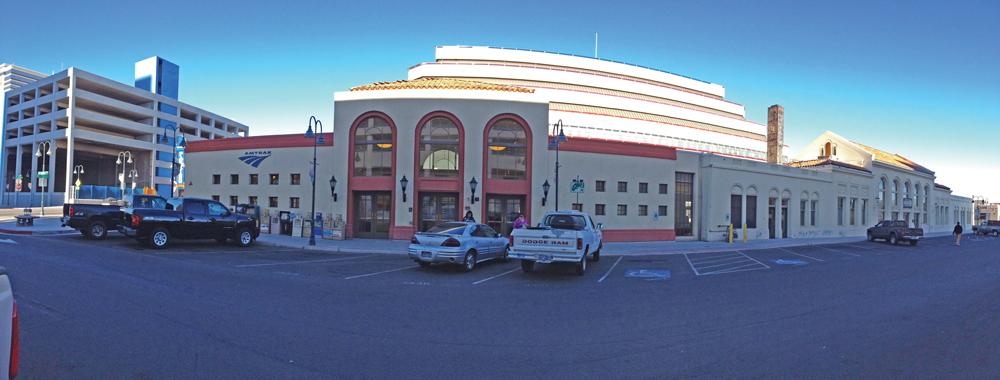
Reno’s first attempts at passenger rail stations were brief and flammable. A station built on the current site in 1869 burned to the ground a decade later, and an 1889 replacement met a similar end. Finally, with loads of fire-retardant precast concrete on hand, the Southern Pacific railroad constructed what’s essentially the current building (above) in 1926.
The Amtrak station’s relative inconspicuity is actually a good thing, and the result of several million dollars of public works. Completed in 2006, the Reno Transportation Rail Access Corridor (ReTRAC) represented the biggest engineering project of its kind since the city’s founding. ReTRAC unclogged much of downtown’s intermodal traffic congestion, thanks in large part to a colossal trench that submerged two miles of track and led to the odd subterranean positioning of the Amtrak station’s platform, which sits 33 feet below street level.
Architecturally, the Reno Amtrak station is that rarest of structures—both purpose-built and aesthetically pleasant. Like many Southern Pacific stations designed during the Roaring ’20s, Reno’s was built in that distinctively American style dubbed Mediterranean Revival—featuring red tile, Serlian windows, and other homages to the Italy of yesteryear.
Reno’s Amtrak station is more than just a curiosity. It’s one of a kind, at least in Nevada. If you exclude the small red-brick shelter with a waiting room in Winnemucca, and the functional platform at the edge of a secluded industrial area in Elko, Reno’s is the only full-fledged Amtrak station in the state. As of 2009 Amtrak trains no longer visit the Union Pacific depot in neighboring Sparks. Amtrak also discontinued service to Las Vegas’s Union Station in 1997, rendering the city the nation’s largest metropolitan area without passenger rail service.
With the decreasing importance of rail travel over the generations, it’s only natural, if regrettable, that your typical train station is an afterthought for most people. But for the more intrepid traveler, one who values unobstructed scenery and generous legroom, Amtrak and its Reno station represent a return to normalcy.
The station averages around 190 passengers a day, roughly half heading west to Sacramento and beyond to the line’s terminus in San Francisco (technically Emeryville in the East Bay), the remainder heading east. Those passengers are riding the California Zephyr, whose westbound #5 Train stops at Reno at 8:36 a.m. every day.
Reno is a major embarkation and disembarkation point and the first manned station since Salt Lake City, a protracted 594 miles to the east. The eastbound Zephyr, the #6 Train, rolls into Reno at 4:06 p.m. A day and a half later, after making its way through Denver and Omaha, the Zephyr finally comes to a stop in the nation’s railroad hub of Chicago.
One recent traveler on the #5 was Rachel Kurmanay, a sprightly 74-year-old Renoite who visits Northern California every couple of months. Her driving days behind her, the grandmother of six was delegating her transportation to other people on a recent crisp autumn morning: first, the family friend who drove her to the station; second, the Amtrak engineer who’ll take over for the remainder of her journey.
As fate and family relocation patterns would have it, all but one of Kurmanay’s six grandkids just happen to live a few stops away on the California Zephyr’s route. Get Kurmanay talking about riding the rails, and her eyes illuminate. “Comfort, convenience…(train) travel is much more pleasant,” she emphasizes, faint remnants of a childhood Russian accent still imbuing her English.
A striking feature about Amtrak’s Reno operations is how capital-intensive they are. The equipment is modern, and the employees scarce. Scarce, but not invisible. The daily bustle of the Amtrak station doesn’t just happen organically. Its order and precision are the work of a professional staff who, as the idiom goes, make the trains run on time.
At the controls is Jim Williamson, an affable man whose figurative business card says “station agent” but whose duties include everything from selling tickets, to hoisting bags, to taking a few minutes out of an overflowing schedule to talk about what he does and how the station operates. An Amtrak lifer, the 31-year rail veteran is on the premises well before the #5 Train makes its daily morning appearance.
Reno serves as a base for Amtrak crews, and a crew consists of just a pair of conductors and one or two engineers. Crews used to exchange at the defunct Sparks station but now do so in Reno: a four-person crew toggling between there and Emeryville, a three-man crew between Reno and Winnemucca. It’s the ideal job for workers who love to travel but also prefer to come home at night.
History is on display at Reno’s Amtrak station, too. During the ReTRAC project, excavation unearthed dozens of forgotten artifacts that had lain buried for years. These museum pieces, extracted with great care and now curated for public viewing, sit under glass in the station’s lobby. They include everything from an ancient cistern used to fight fires to perfectly preserved bottles that predate the Civil War.
But the centerpiece of the station’s historical décor is a drinking fountain. If that sounds mundane, it shouldn’t. This is no ordinary fountain. Standing 15 feet high, this wrought-iron masterwork was made for an even more pastoral form of transportation—horses. The fountain sits in the station’s lower level, at the center of the passenger waiting area.
With every running, the California Zephyr snakes through not just our own Sierra Nevada, but over the Rockies and the Great Plains. The Zephyr is famed throughout the world as one of the most scenic routes in all of rail, its endless views in the same class as those of the Adelaide-to-Darwin Ghan and the Moscow-to-Beijing Trans-Siberian. (Having ridden the latter, I assure you that travel on the California Zephyr is several orders of magnitude cleaner, more punctual, more relaxing, more delicious, and in every imaginable way more pleasant.)
As one can well imagine, the route thus draws passengers from around the world, many of them seasonal. Spring is when the bulk of Japanese and Koreans visit. In the fall the Italians and Spaniards predominate, with a healthy smattering of Brits, Germans, and Australians throughout the calendar.
For riders both foreign and domestic, the services of the Amtrak docents are invaluable. Representatives of the California State Railroad Museum serve as onboard narrators and general goodwill ambassadors on selected trains. As the Zephyr retraces the original transcontinental route that long ago finally united a diverse and disparate nation, the docents call out stops on the train’s public address system and draw on their extensive knowledge to answer curious riders’ questions in the lounge car. The ranks of the docents include some of the nation’s, if not the world’s, foremost authorities on trains.
Unlike flyers, rail passengers need not arrive hours before they’re scheduled to depart. Theoretically, you could get to the train station just in time to buy a ticket and dash downstairs to the platform.
However, if you do plan to visit Reno—or conversely, begin in Reno and visit selected places east or west—don’t treat the city’s Amtrak station as a mere point of departure. Get there in plenty of time to explore its magnificence, browse the displays, and breathe in the atmosphere.
Fun Trains
Themed Amtrak rides start the party onboard, then bring it to The Biggest Little City.
By Greg McFarlane

Reno Amtrak agent Jim Williamson says the station becomes particularly active during the winter months. From late January to mid-March, it hosts the chartered Reno Fun Train on weekends (and its sister route, the Reno Snow Train, during the week.)
Thrillseekers from the Bay Area depart San Jose, returning home two days later. The seasonal trains are each decked out in various themes (Mardi Gras, Country & Western, etc.) and include dancing, a piano bar, and even strolling musicians. With ice and mixers on hand, the trains are not for the introverted nor the quiet.
RENO FUN TRAIN THEMES & DEPARTURES
Mardis Gras – February 8
Ski Train 3-day weekend with Truckee stop – February 15
Rock ’n’ Roll – February 22
Soul Train – March 1
1960s Murder Mystery – March 8
St. Patrick’s Day – March 15
RENO SNOW TRAIN THEMES & DEPARTURES
Motown & Bingo Tournament – January 29
Rockin’ Round the ’50s & Bingo Tournament – February 5
Fat Tuesday – February 12
The Rat Pack – February 19
Classic Country with Line Dancing – February 26
1960s Murder Mystery – March 5
Taking the Train
Nevada Magazine’s Associate Editor lets Amtrak do the driving
Story & Photos By Charlie Johnston
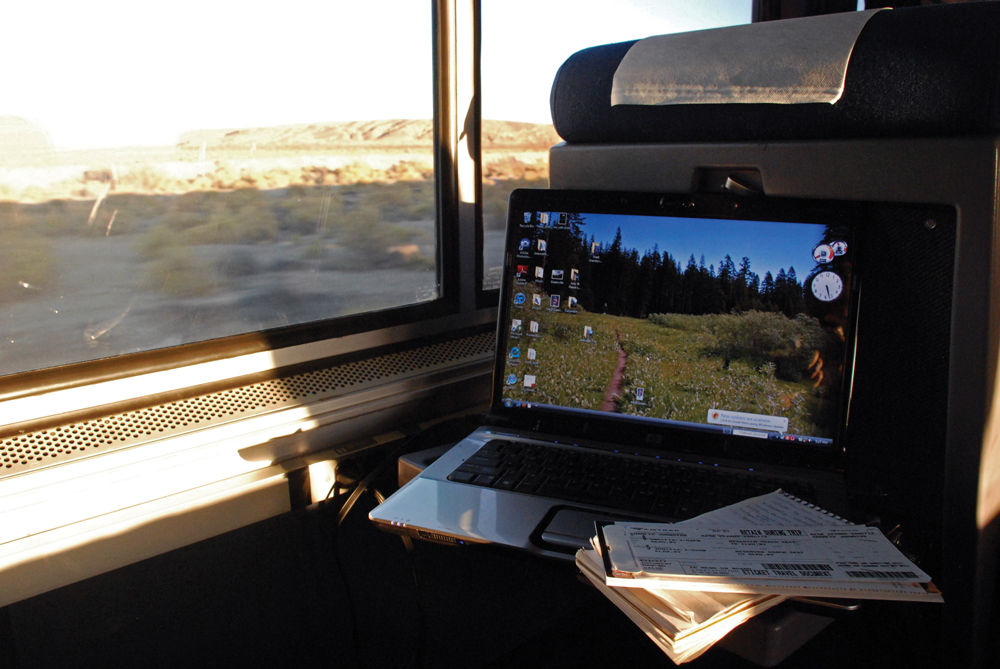
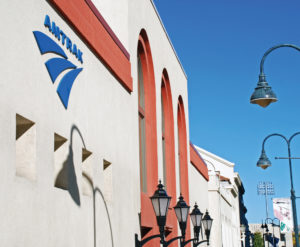 Having spent far too many hours negotiating security at airports, I was prepared for a Spanish Inquisition-style screening when I arrived at the Reno Amtrak Station one afternoon in October to catch the #6 California Zephyr to Elko. I was pleasantly surprised when the friendly conductor scanned my ticket, allowed me to remain in my shoes, and was onto the next passenger in mere moments. No driving, no intrusive security process—I was starting to get on board with the idea of train travel.
Having spent far too many hours negotiating security at airports, I was prepared for a Spanish Inquisition-style screening when I arrived at the Reno Amtrak Station one afternoon in October to catch the #6 California Zephyr to Elko. I was pleasantly surprised when the friendly conductor scanned my ticket, allowed me to remain in my shoes, and was onto the next passenger in mere moments. No driving, no intrusive security process—I was starting to get on board with the idea of train travel.
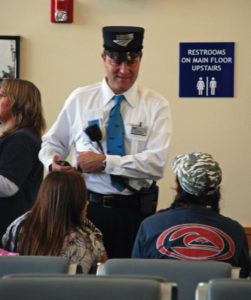 Tom Sponsler of Amtrak Marketing & Sales tells me after the fact, “Even though we don’t have a security setup like one sees at airports, the safety and security of our passengers is very important to Amtrak.” I soon found myself on the upper deck of the coach cabin, free to select a roomy and comfortable pair of seats. Here, again, I warmed to the simple, hassle-free pace of train travel and the fact that my knees came nowhere near to touching the seatback in front of me. Following a couple of brief announcements from the engineer, the train was off, slowly chugging to speed and softly rocking as it pushed east out of Reno and Sparks. Relieved to be underway, I sat back and watched the fall colors blur past as we made our way along the Truckee River.
Tom Sponsler of Amtrak Marketing & Sales tells me after the fact, “Even though we don’t have a security setup like one sees at airports, the safety and security of our passengers is very important to Amtrak.” I soon found myself on the upper deck of the coach cabin, free to select a roomy and comfortable pair of seats. Here, again, I warmed to the simple, hassle-free pace of train travel and the fact that my knees came nowhere near to touching the seatback in front of me. Following a couple of brief announcements from the engineer, the train was off, slowly chugging to speed and softly rocking as it pushed east out of Reno and Sparks. Relieved to be underway, I sat back and watched the fall colors blur past as we made our way along the Truckee River.
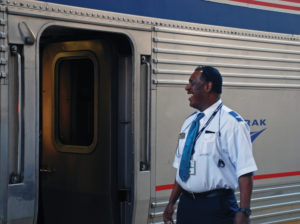 Since the #6 Zephyr departs Reno at 4:06 p.m. daily, the scenery quickly fades into darkness in the fall and winter, but thanks to the full moon that accompanied my trip, the desert was painted with a surreal blue glow and long dark shadows. After a quick stop in Winnemucca, the train reached Elko very close to its scheduled 9:31 p.m. arrival.
Since the #6 Zephyr departs Reno at 4:06 p.m. daily, the scenery quickly fades into darkness in the fall and winter, but thanks to the full moon that accompanied my trip, the desert was painted with a surreal blue glow and long dark shadows. After a quick stop in Winnemucca, the train reached Elko very close to its scheduled 9:31 p.m. arrival.
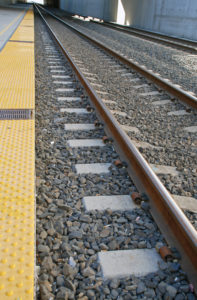 Following my brief stay in Elko, the #5 California Zephyr rolled up to the train platform a few minutes before its scheduled 3:03 a.m. arrival. Glad to escape the cold predawn air, I climbed aboard and found an open pair of seats among the handful of sleeping passengers.
Following my brief stay in Elko, the #5 California Zephyr rolled up to the train platform a few minutes before its scheduled 3:03 a.m. arrival. Glad to escape the cold predawn air, I climbed aboard and found an open pair of seats among the handful of sleeping passengers.
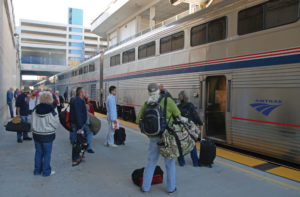 By my closest estimation, the sun started to rise at about the same point on the return journey as it had set the previous evening, filling the coach cabin with light and coaxing its passengers from their slumber. Staring out the window at the breathtaking pink, purple, yellow, and orange sky, I struggled to remember the last time I had actually watched the sun start a new day. I drive to work with the rising sun every day, but rarely so much as turn my head to appreciate it.
By my closest estimation, the sun started to rise at about the same point on the return journey as it had set the previous evening, filling the coach cabin with light and coaxing its passengers from their slumber. Staring out the window at the breathtaking pink, purple, yellow, and orange sky, I struggled to remember the last time I had actually watched the sun start a new day. I drive to work with the rising sun every day, but rarely so much as turn my head to appreciate it.
Rubbing the sleep from my eyes to better view the spectacle and settling in for the remaining time until the train pulled into Reno at 8:36 a.m., I smiled, pleased with my decision to let Amtrak do the driving this time.



